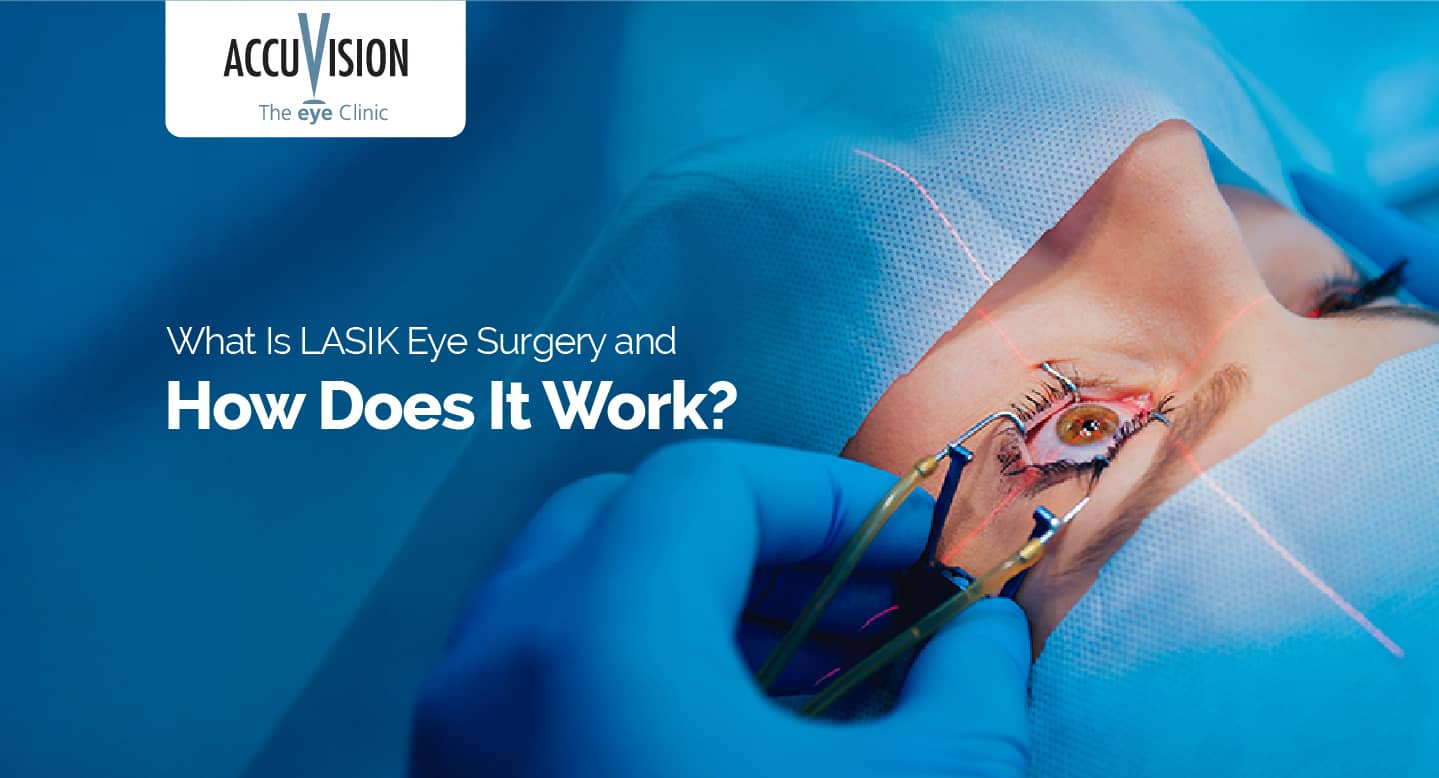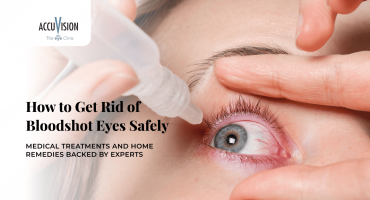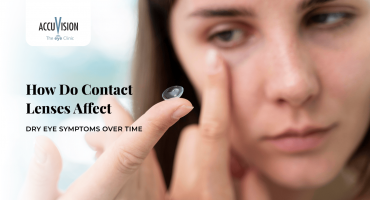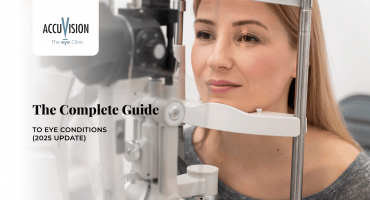- What Is LASIK Eye Surgery?
- How LASIK Is Performed: Step by Step
- What to Expect Right After LASIK
- Benefits of LASIK and AccuVision’s Advanced Technology
- LASIK Problems: Are There Risks?
- LASIK FAQ: Your Top Questions Answered
- Final Thoughts

LASIK is a popular choice for people with vision problems like short-sightedness, long-sightedness, or astigmatism. It reshapes the cornea to help light land correctly on the retina. Many people find their vision improves, often reducing or eliminating the need for glasses or contact lenses.
So what actually happens during LASIK? This guide walks you through each step of the procedure, what to expect during recovery, typical outcomes, and the factors that influence cost.
What Is LASIK Eye Surgery?
LASIK is a laser-based treatment that adjusts the shape of the cornea, the clear outer part of the eye, to help light focus properly on the retina. When the cornea is uneven, it causes blurred vision. Reshaping it can bring images into focus and often reduce the need for corrective eyewear.
How LASIK Is Performed: Step by Step
Preparation (Numbing the Eye)
Numbing eye drops are used before the procedure begins. You’ll be awake, but there is no pain, just a bit of pressure or light sensation. The medical team will guide you through the process and help you stay at ease.
Creating the Corneal Flap
A thin flap is created on the surface of the cornea using either a precise blade or a femtosecond laser, depending on the technique selected. Lifting the flap gives the surgeon access to the underlying corneal tissue for reshaping. It’s very thin.
Modern LASIK technology allows ultra-thin flaps for safety, and it remains attached on one side, acting as a natural bandage that will be put back in place later. After the flap is made, it is carefully lifted to reveal the stroma, the inner layer of the cornea where the laser treatment is applied.
Reshaping the Cornea
With the flap open, the surgeon uses an excimer laser to precisely reshape the stroma, the inner layer of the cornea. This adjustment is tailored to your specific prescription and improves how light is focused onto the retina, resulting in sharper, clearer vision.
This laser is extremely precise, removing microscopic amounts of tissue to refocus how light enters your eye. At AccuVision, the surgeon utilizes advanced technology like the WaveLight™ excimer laser, which operates at 500 pulses per second for ultra-fast, accurate treatment.
During this step, AccuVision also incorporates any personalized treatment profiles, such as Wavefront-guided or Topography-guided corrections, into the laser programming to address even subtle vision imperfections. These custom profiles (generated from detailed maps of your eyes) help achieve the sharpest vision and reduce issues like glare or halos at night. The laser reshaping typically lasts only seconds per eye.
During the procedure, you’ll be asked to look at a fixed light so the laser can carry out the correction accurately. You won’t feel the laser, aside from the pressure of the instrument holding your eye open.
Placing the Flap Back:
Once the laser treatment is complete, the surgeon carefully sets the corneal flap back into place, restoring the surface of the eye without the need for stitches. It stays in place on its own, without the need for stitches, and serves as a natural barrier to protect the treated area.
Healing begins quickly, often starting as soon as the flap is set back in place. The surgeon will smooth it out to ensure it’s properly aligned. Because the surface cells of the cornea start reconnecting quickly, the flap will stay secure as it heals.
Protective Contact Lens (if needed):
In many cases (such as at AccuVision), a clear bandage contact lens is placed over the cornea at the end of LASIK surgery. This thin, soft contact lens protects the flap and keeps the surface moist and safe while the initial healing takes place. Typically, you’ll wear this bandage lens for the first day or so, after which a follow-up appointment will remove it. Not all clinics use a bandage lens for LASIK, but when they do, it’s an added precaution to promote comfortable healing.
Also read: LASIK: Leading Laser Eye Surgery Procedure
What to Expect Right After LASIK
Immediately after the procedure, patients typically rest for a short period before heading home. Surprisingly, many people start noticing clearer vision within minutes of the procedure. Your eye surgeon or care team will check your eyes and go over aftercare instructions before sending you home. It’s normal to have some blurry vision and watery eyes at first as the numbing wears off.
Medicated drops are provided after surgery to help prevent infection and keep the eyes lubricated and comfortable as healing begins. Most patients are amazed at how quickly their vision improves by the next morning; they often wake up seeing clearly without glasses. Typically, you can resume normal daily activities within a couple of days, though you should avoid rubbing your eyes and follow all the recovery guidelines provided.
Every individual heals slightly differently, but generally within a few days you can get back to your routine, and vision continues to sharpen over the following weeks. The clinic will schedule follow-up visits to monitor your healing and results.
Benefits of LASIK and AccuVision’s Advanced Technology
- Fast Recovery: Most patients see functional improvement within 24 hours and return to work or daily routines in a day or two, with sensible precautions.
- Minimal Discomfort: Numbing drops make the procedure nearly painless. Any post-treatment symptoms are usually mild and brief. No general anaesthetic is used, and the team stays by your side throughout.
- High Accuracy and Long-Term Results: LASIK offers precise vision correction. Most patients achieve 20/20 or better, and over 99% can drive without glasses. The corneal reshape is permanent, though normal age-related changes can still occur.
- Treats a Wide Range of Prescriptions: LASIK covers mild to severe nearsightedness, farsightedness, and astigmatism if your eye health and cornea thickness meet criteria. Even some previously deemed unsuitable may be eligible with AccuVision’s tech.
- More Freedom in Daily Life: After LASIK, many enjoy tasks like reading, traveling, sports, and night driving without visual aids. For many, it’s a life-changing experience.
LASIK Problems: Are There Risks?
When performed on appropriate candidates by qualified surgeons, LASIK is extremely safe. Possible side effects include:
- Common (usually temporary): dry eyes, glare, halos, starbursts, and fluctuating vision in the first weeks.
- Rare: Infection, flap issues (dislocation or wrinkles), over- or under-correction. These are often correctable with drops or follow-up treatment.
Thorough screening and careful aftercare help minimise risks.
Laser Eye Surgery Pricing in the UK
The cost of laser eye surgery depends on a few key factors, including the type of treatment, the technology used, and the level of follow-up care. Below is a general overview:
- Video screening consultation – Free of charge
- In-depth diagnostic consultation – Starting at £150
- Laser vision correction – Starting from £999
All quoted prices are inclusive, meaning they cover the full package—surgery, post-treatment check-ups, and any necessary enhancements.
What Influences the Cost?
- The specific laser technique used (e.g., standard vs. custom treatments)
- Equipment quality (such as excimer or femtosecond lasers)
- The surgeon’s qualifications and track record
- How comprehensive the aftercare plan is
While the upfront cost may seem significant, many patients find that LASIK pays off over time. It often replaces the need for glasses, contact lenses, and the ongoing expense of maintenance products.
LASIK FAQ: Your Top Questions Answered
Q1. Is LASIK painful?
No. Numbing drops are used during the procedure. You may feel pressure or slight discomfort afterward, but the pain usually eases within hours.
Q2. How soon can I return to work?
Most people return within 24–48 hours, depending on vision and job demands.
Q3. Can LASIK fix astigmatism?
Yes. It reshapes the cornea to reduce or eliminate astigmatism.
Q4. Will I need glasses in the future?
LASIK corrects your current prescription. As the eyes age, conditions like presbyopia can still develop, which might mean using reading glasses in the future.
Q5. Is LASIK safe?
Yes. When done on suitable candidates, LASIK has very high success and low complication rates.
Q6. What if my vision changes later?
Enhancement procedures can fine-tune vision. Many clinics include these within the original cost.
Final Thoughts
LASIK offers fast recovery, lasting results, and a chance to live without glasses or contacts. With tailored plans, modern laser systems, and experienced surgeons, it can be a transformative experience in just a few days.
Do your research on LASIK cost, compare it with PRK, and discuss your suitability with a surgeon. The results speak for themselves.
If you have more questions, book a consultation to find out if LASIK is a good fit.








